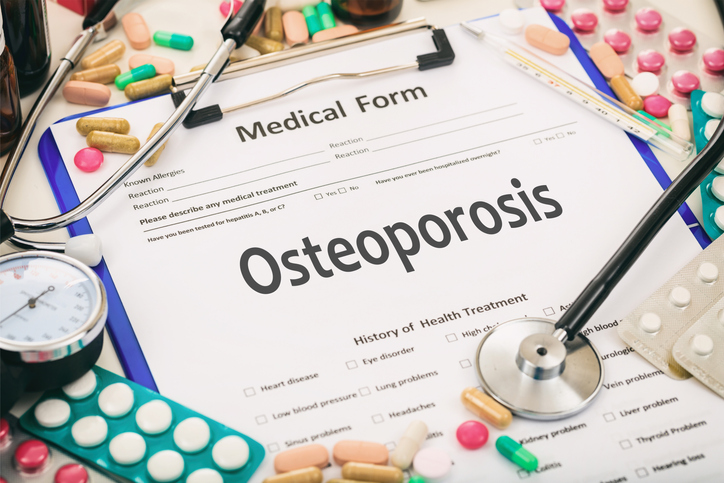May is osteoporosis awareness and prevention month. What is osteoporosis? Learn more about this common condition, and the steps you can take to prevent it.
May is osteoporosis awareness and prevention month—making it the perfect time to learn more about this common condition, and the steps you can take to prevent it. In this post we'll cover a range of tips and intelligent strategies for keeping your bones strong and vibrantly healthy.
Remember: It's never too early or too late to take steps to protect your bones from osteoporosis!
What Is Osteoporosis?
The National Institute on Aging offers this definition of osteoporosis:
"Osteoporosis is a disease that weakens bones to the point where they break easily—most often, bones in the hip, backbone (spine), and wrist. Osteoporosis is called a "silent disease" because you may not notice any changes until a bone breaks. All the while, though, your bones had been losing strength for many years."
Like skin, muscles and tendons, our bones are living tissues. To maintain the health and strength of bones, the body breaks down old or damaged bone and replaces it with new bone tissue. As we age, this bone-replacement process tends to slow down. As a result, the bones may become porous and more susceptible to fractures.
The Signs & Symptoms Of Fractures
Bone fractures come in a variety of types: from tiny hairline stress fractures to very serious compound fractures. If you suspect that you may have a bone fracture, it's important to immediately seek medical assistance.
The signs and symptoms of a broken bone include:
- Swelling or bruising over a bone
- Deformity of an arm or leg
- Pain in the injured area that gets worse when the area is moved or pressure is applied
- An inability to bear weight on the affected foot, ankle, or leg
How To Strengthen & Protect Your Bones
The good news is that there are things you can do to keep your bones healthy and minimize the risk of osteoporosis and/or fractures. The most important of these revolve around diet and exercise, which we'll cover in more detail now.
Osteoporosis Nutrition Guidelines
Changing dietary habits is a crucial step in preventing osteoporosis. Getting sufficient amounts of calcium, vitamin D, and vitamin C from the foods you eat is especially important. Here are the basic elements of a bone-healthy diet: 
1. Fresh Fruits For Vitamin C
Include fresh fruits such as pineapple, strawberries, oranges, apples, bananas, kiwi, papaya and guavas. These fruits are all loaded with vitamin C, which helps to strengthen your bones. One of the most potent (though lesser-known) fruit sources of vitamin C is camu-camu, which is available as a supplement powder.
2. Dark Leafy Greens For Calcium
Among vegetables, it's the dark leafy greens that tend to be highest in calcium levels. Great choices here include spinach, kale, Swiss chard, beet greens, collard greens, mustard greens, arugula and dandelion greens. To ensure that the nutrients from greens become fully available to the body, the leafy greens should be fully cooked (e.g. steamed or sautéed) until tender.
3. Calcium-Rich Foods To Prevent Osteoporosis
Some additional foods that are high in calcium include:
- canned sardines or salmon (with bones)
- yogurt or kefir (make sure to choose brands that have "live active cultures") .

- dried figs
- cheese
- kale
- collard greens
- okra
- bok choy
- almonds
- broccoli
Try to include at least one or two of these calcium-rich foods in your meals each day.
4. Increase Vitamin D via Sunshine & Diet
One excellent way to increase your body's supply of vitamin D is to spend some time in the sun (without sunscreen). Between five and thirty minutes of sun exposure, at least twice per week, is a good rule of thumb.
We also recommend eating foods rich in vitamin D, which include:
- cod-liver oil
- wild-caught salmon
- mackerel
- tuna fish
- fortified milk
- sardines
- beef liver
- eggs
- caviar
- mushrooms
5. Add Bone Broth To Your Diet
One of the best additions to your diet to support bone health is bone broth. It's fairly easy to make it yourself. If you purchase it in a store, make sure to get an authentic bone broth—e.g. Bonafide Provisions Bone Broth—which will be gelatinous at room temperature.
Have Fun With These Bone-Healthy Recipes
Now that you know which foods to add to support healthy bones, you might be wondering how exactly to put them together into dishes that are as delicious as they are nutritious. We've got you covered!
The International Osteoporosis Foundation has a wonderful variety of bone-healthy recipes to choose from: orange almond flan, chicken and fennel pita, salmon burger, Korean pan-fried tofu—to name just a few of the 100 or so delicious recipes available here.
Bone Health Supplements
 For some people, an intelligent diet—as outlined above—is sufficient in providing the nutrients required for healthy bones. But others may require an additional boost, in the form of a multivitamin or supplement.
For some people, an intelligent diet—as outlined above—is sufficient in providing the nutrients required for healthy bones. But others may require an additional boost, in the form of a multivitamin or supplement.
While it's always a good idea to consult your general practitioner for advice, these two supplements are beneficial for almost everyone:
- Capra Mineral Whey. Includes a wide spectrum of vitamins and minerals (including calcium) in a natural, whole-food matrix.
- Multi-Collagen Protein Powder. Excellent all-around support for collagen: a structural protein vital to bone strength, as well as the health of the skin, muscles, tendons and ligaments.
Exercises To Prevent Osteoporosis
There are two categories of exercises that are particularly important for building and maintaining bone density. Participating in one (or several) of these activities, at least three times a week, will help to keep your bones healthy.
- Low-impact weight-bearing exercise.For example: walking, hiking, stairmaster or treadmill, tennis or pickleball, low-impact aerobics, gardening, dancing, restorative yoga,tai-chi or Feldenkrais.
- Muscle strengthening exercises.For example: weight training or kettlebell workouts.
What To Avoid If You Have Osteoporosis
As we've already discussed, to prevent osteoporosis it's important to maintain an excellent diet and to exercise regularly. In other words, avoid becoming a couch potato! Instead, stay physically active and take pride in creating a bone-healthy diet.
If you've already been diagnosed with osteoporosis, it's probably best to avoid activities that involve twisting the spine or bending forward from the waist—for instance sit-ups, toe touches, or swinging a golf club.
The Bottom Line
With intelligent lifestyle choices, you can maintain healthy strong bones well into your wisdom years. Enjoy!
Questions or comments? Please feel free to contact us.

